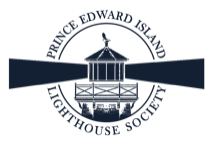Lighthouse: Enclosed tower originally designed with an enclosed lantern and built by a governing authority as an aid to navigation.
Lightstation: Light tower and associated buildings(dwellings, sheds, fog alarm, etc) and the lands they occupy.
Aid to navigation: A buoy, beacon, lighthouse, lightship or any other structure or device, installed, built or maintained for the purpose of assisting the navigation of vessels.
Automated: A lighthouse which has been changed to operate without a keeper. Sometimes a keeper is retained for maintenance and security.
De-staffed: An automated lighthouse which does not have a keeper.
Active Lighthouse: One that is currently operating.
Decommissioned: No longer functions as a navigation aid because the light has been turned off or has been removed.
LOL: List of Lights, Buoys, and Fog Signals. It is an official government list of navigation aids featuring brief descriptions and precise locations. Regular updates are published in Canadian “Notices to Mariners” (NOTMAR Website).
Characteristic: The unique visual identity of a lighthouse including the light exhibited and the individual features of the structure which allow mariners to distinguish one lighthouse from another.
Daymark: The marks on a lighthouse or range light which allow mariners to distinguish one lighthouse from another in the daytime. For example, the broad black bands on the West Point Lighthouse or Tignish Lighthouse. As well, mariners entering a harbour line up the vertical red stripe on the front range light with the one on the back range light, to guide the ship safely into the harbour.
The Flash Pattern ( a series of light flashes and eclipses (darkness) identify the light. We will include terms which you will find in the descriptions of PEI Lighthouses as well as their abbreviations.
- Fixed: F. A light which appears continuous and steady and of a constant colour.
- Range Lights: Two or more lights associated to form one or more leading lines (or ranges)
- Sector light: A light presenting different characters (usually different colours) over various parts of the horizon of interest to mariners. Leard's Front Range Light.
- Flashing: Fl. A light in which the total duration of light in each period is clearly shorter than the total duration of darkness and in which the flashes of light are all of equal duration.
- Equal-Interval. (Isophase) Iso: A light for which the alternations of light and darkness are of equal duration.
- Occulting. Oc: A light in which the total duration of light in each period is clearly longer than the total duration of darkness and in which the intervals of darkness (occultations) are all of equal duration.
- Lfl: Long flash. Ex: Howard's Cove Lighthouse characteristic is 2 sec flash, 4 sec eclipse for a cycle of 6 seconds.
Sector Light: A light showing three different colours. Found at Leard's Front Range Light.
Nominal Range: The distance at which a light can be seen in clear weather. This is given in nautical miles.
Focal Height: the distance from sea level to the center of the illuminating light.
Faux lighthouse: Animitation lighthouse.
Lighthouse Anatomy:
Cornice: Ornamental overhang often found on lighthouses as a decorative treatment below the lantern or gallery deck. Sometimes separated from the shingled side of the tower by a plain strip of wood called a fascia.
Octagonal towers are eight-sided.
Some multi-sided lighthouse lanterns have ten or more sides (polygon). A twelve sided shape is called a dodecagon polygon. EX: West Point
Lantern: The exterior enclosure that protects the lens and lamp. Often confused with the lens or lamp, it is actually the top portion of the lighthouse from the deck up.
Lantern Deck: The exterior walkway around the lantern deck which was used for cleaning windows and maintenance.
Smoke Jack: A special stack on top of older lanterns used to vent smoke from the lamps, sometimes shaped like a round ball(ex. Wood Islands LH) or a chimney with a metal vane.(ex. Cape Egmont)
Light Room: The room directly below the lantern. Here the keeper stored tools, cleaning supplies, etc. The air and fuel tanks were located there..
The weight shaft contained a system of weights and pulleys which rotated the lighting mechanism. It opened on the Light Room floor.
Lighthouse Technology:
Lamp: The lighting apparatus inside the lens. (ie. Oil lamp, kerosene vapour burner, electric light bulb).
Lens: Any glass or transparent material which is shaped to concentrate magnify and focus light.
Catoptric: A light which uses a concave mirror for magnification. Often indicated in LOL as “C”. They were common before widespread use of Fresnel lenses but continued in some lighthouses long after.
Dioptric: A light which uses a lens for magnification.
Fresnel: The lens invented by Austin Fresnel in 1821 which consisted of concentric ridges radiating outward from the central lens (bull's eye), with prisms positioned at the top and bottom of the ridges to refract the light from the light source placed behind the central lens.
Drum Lens: A common variety of the Fresnel lens but lacking a central bull's eye and having an open cylinder or “drum”.
Order: A measurement of the size of a Fresnel lens, with the 1st order being the most powerful (and largest) and the 7th order being the least powerful (and smallest).
7th, 6th & 5th order: small harbour and inland lights. Example: Warren Cove Range Lights
4th and 3th order: lesser coastal lighthouses. Most of the larger lighthouses on PEI are equipped with 4th order lenses which show for a distance of 15 miles in clear weather.
Mercury Vapour Lights (M.V.) will under certain atmospheric conditions, show a greenish hue, rather than white, which might be how it is listed in the List of Lights.
FHBRO: Federal Heritage Building Review Office. The primary objective is to assist government departments in the protection of their heritage buildings. To achieve this aim, they prepare extensive reports
